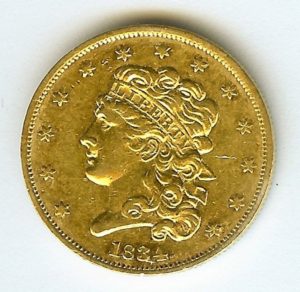Classic Head $5 Gold Half Eagle (1834–1838)
The Mint Act of 1834 ushered in the age of using gold coinage in the US. There have been cold coins in the past, but they weren’t always widely circulated. The coins contained a lot of gold, and the passing of the Mint Act of 1834 called for reducing the amount of gold used. The Classic Head $5 coin was part of this new specification for gold coins.
History of the Classic Head $5 Half Eagle
Excited about getting new gold coins into circulation, US Mint Director Samuel Moore asked Engraver William Kneass to create a new design. Kneass settled for a Liberty with tousled hair and facing her left. She had a headband with the words LIBERTY inscribed on it. The date was placed below the head, which was circled by 13 stars.
The reverse of the Classic Head $5 still featured the raised-wing eagle found in previous issues. Surrounding the eagle were the words UNITED STATES OF AMERICA and the value 5 D.
Mint officials weren’t fully satisfied with Kneass’ design and as such, minor changes were introduced all throughout the run of the series. Christian Gobrecht made further changes beginning in 1836 when Kneass’ health faded.
The Classic Head design had a five-year run and throughout those years, it went through a series of changes. Some involved changes to Liberty’s hair while others had variations on the number 4 (plain or crosslet).
The Classic Head coin circulated at a time of great economic disturbance. During its last years, the coin circulated through a disastrous period called the “Hard Times.”
Variations of the Classic Head $5 Half Eagle
The Classic Head half eagle was produced between 1834 and 1838. More than 2.1 were struck during those years, most of them at the Philadelphia Mint.
By 1838, new mints opened up at Charlotte, North Carolina and Dahlonega, Georgia. Coins produced at these mints bear marks on the obverse side, over the date. The more than 17,000 coins minted in Charlotte bear the C mark while the 20, 583 pieces struck at Dahlonega were marked with D.
The new Classic Head half eagles remained in circulation many years after it was first released. One of the reasons for it being so was it bore the same size and weight as the Coronet Head coins that came later.
Collecting the Classic Head $5 Half Eagle
Many collectors are drawn to the Classic Head half eagles produced at the Charlotte and Dahlonega mints because they were produced in limited numbers. However, there are only a few in the series with a high grade, making the coin a not-so-valuable acquisition by collectors.
There are, however, rarities in the series. The 1838 coin produced in Charlotte is one, with others being the 1834 Crosslet 4 coin and the 1838 Dahlonega.
The Kneass Classic Head design yielded to the Coronet Head by Gobrecht in 1838, which improved upon mechanical qualities. Despite that, it remained in circulation for decades thanks to being the same size and weight as the design that came after it.
